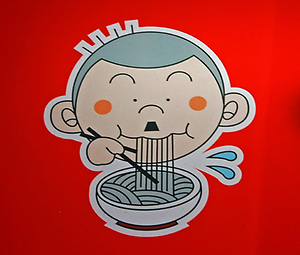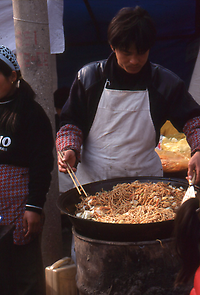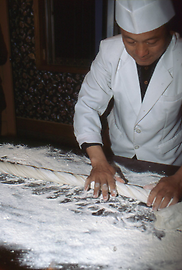Noodles around the world#
Noodles can be considered THE universal dish that is liked by almost anyone#
By

Not too long ago, two nations have argued over which of the two „invented“ noodles. The Italians claimed that they have invented noodles and that the most important traveler of the Middle Ages, the Venetian Marco Polo brought noodles to China. However, the Chinese saw it the other way aroudn: the Italian merchant and adventurer got to know noodles in China and brought the knowlegde about them back home to Europe.
Today, there are doubts that Marco Polo actually went to China or if he perhaps wrote his book based on hearsay from those travelers he met in the Middle East and who had really managed to reach East Asia.
The dispute between the two nations was settled long ago. The procedure for preparing noodles was developed polygenic, meaning that noodles have started in different places under approximately the same conditions. The decisive factors were the climatical and botanical conditions. Noodles are made from wheatflour and wheat semolina which have been cultivated both in Italy and China.
China is divided into two huge culinary regions. In the northern part, wheat and other cereals are cultivated. However, in the southern part rice is grown. In the Occident, during the Young Stone Age, nomads settled as farmers. In this period, wheat was growing out of wild grass through natural selection in long-lasting developments. In Asia, the universal noodle dishes have spread to all neighbouring countries. Noodle dishes have also spread from Italy to western countries and have become an important part of western cuisine.
In China, archeological excavations in the pre-historical village Lajia prove that noodles had been already prepared in the 3rd millenium B.C. Noodles were found inside a sealed ceramic bowl at a burial site. The noodles were made from millet flour, had a length of 50cm and a diameter of 3mm.
The opinion that Marco Polo introduced noodles in Italy ís obsolete. In ancient Greece, noodle dishes were already eaten. In the 1st century B.C., Romans had noodles on their menus. The writers Cato the Elder and Horaz reported on it and the Latin words recorded by them lead linguistically and culinary to today’s Italian cuisine. The words for various noodle dishes were taken over by Romans from Greeks as loanwords. The Italian word Lasagne comes from the Latin word lagana, a loanword from Greek láganon. The popular Tagliatelle derives from the Greek word trakton, that the Romans took over as tracta.

Photo: G. Jontes, under CC BY 4.0
The general term for all Italian dishes made from noodle dough is pasta. The ingredients of pasta are semolina made from durum wheat, water and table salt. In Rome, there is even a museum of macaroni and spaghetti ("Museo nazionale delle paste alimentari") that documents the culture of this very Italian food.
How much the Romans learned from Greeks in the food sector is documented by an ancient Italian word that had the original meaning barley porridge in Greek language. Of course, barley porridge was salted accordingly. The word salted means pastos in Greek language.

Photo: G. Jontes, under CC BY 4.0
The origin of the German word Nudel is not yet completely clarified. It seems to have something to do with the word Knödel(dumpling). In Germanic, the root kn expresses a thickening such as the German words Knödel (dumpling), Knolle (bulb), Knospe (bud). Therefore, it is supposed that Nudel is named after the basic shape, a piece of dough.
The Italian cuisine has the largest bvariety of shapes of noodles with exactly defined names. The Italian words Spaghetti and Makkaroni became even part of German vocabulary.

Photo: G. Jontes, under CC BY 4.0
For reasons of simplification, other languages use the Italian names to express noddles in general: in Arabic makaruna, in Basque makaroi, Finnish makaronit, Polish makaron, Portuguese makkarao, Russian wermishell (< Italian vermicelli!), Spanish pastas. The German word „Nudel“, you find in French as nouilles and in Breton as nouilhezenn. The Germanic languages also derive their terms from German: Danish nudler, Icelandic nudhla. Slavonic languages take over partly from German such as nudle in Czech language. However, in Slovenian and Croation the word rezanci comes from rezati, meaning to cut in Italian. Noodle dough is cut manually to noodles.
The Asian noodle culture spread from Northern China to the East and West. The Chinese noodle (mie) consists of wheat flour, water and table salt. The same dough is used for the famous Chinese dumplings (jiao tze) with delicate fillings of vegetable, meat, shrimps, etc. In the simplest version noodles are offered in a soup. In China, the noodle soup represents a main dish and is offered at all times. Apart from noodles, the soup contains also vegetables, meat, fish or prawns.
The soup is boiled very quickly and can be enjoyed at any time. The culinary skills of Chinese cooks is manifested by the fact how fast they produce big portions of noddles out of a piece of dough. You can hardly follow with your eyes, how they turn and fold the dough again and again. At the end, they show us what they call „thousand hair nooldes“. They are served fresh on the table either as part of a simple soup or dish, or as part of glamorous feasts consisting of one hundred courses: There are hardly any places other than China who practice culinary festivals as they sometimes do.

Photo: G. Jontes, under CC BY 4.0

Photo: G. Jontes, under CC BY 4.0

Photo: G. Jontes, under CC BY 4.0

Photo: G. Jontes, under CC BY 4.0

Photo: G. Jontes, under CC BY 4.0

Photo: G. Jontes, under CC BY 4.0

Photo: G. Jontes, under CC BY 4.0

Photo: G. Jontes, under CC BY 4.0

Photo: G. Jontes, under CC BY 4.0

Photo: G. Jontes, under CC BY 4.0

Photo: G. Jontes, under CC BY 4.0

Photo: G. Jontes, under CC BY 4.0

Photo: G. Jontes, under CC BY 4.0

Photo: G. Jontes, under CC BY 4.0

Photo: G. Jontes, under CC BY 4.0

Photo: G. Jontes, under CC BY 4.0

Photo: G. Jontes, under CC BY 4.0

Photo: G. Jontes, under CC BY 4.0

Photo: G. Jontes, under CC BY 4.0
Related by culture to China, Vietnam has the famous Po-soup as main dish or as important part of the breakfast. These are long, flat ribbon noodles in a soup. Boiled and fried, it is also served as Pho Xao.
In Thailand, fried noodles are named Phat Thai or Phat Thai Gung Sott and, if added to a clear soup, Tom Yum. Phat Thai consists of shrimps, dried shrimps, fish sauce Naam Plaah, soy sauce, pepper, garlic, shallots, peanuts, tofu, bean sprouts, lime, eggs, rice vinegar and sugar- indeed a good company for the broad rice noodles tha are used.
The national Indonesian cuisine contains simple, tasty fried noodles called Bami goreng. The words for noodles, Mihun and Bakmi derive from Chinese language.

Photo: G. Jontes, under CC BY 4.0
In Japan, Miso-soup is considered to be a healthy appetiser. Chukamen are the noodles in Japna when Chinese recipes are used. There are also noodles made from buckwheat flour named soba. A funny food eating festival is even dedicated to soba. On this occasion, participants swallow meter long noodles in big quantities out of a soup. Other words for noodles are ramen, champon, yakisoba, somen. Udon-noodles are slightly thicker than the others.
Dangmyeon-noodles made from mung bean starch or potato starch and water are a tasty part of the Korean national cuisine. Kaigaksu are noodles cut with a knife. Even in the culinary poor Tibet offers noodles swimming in a warming thukpa-soup.

Photo: G. Jontes, under CC BY 4.0
Noodles processed from dough are named hé fén in China and senyai in Thailand. In Korea, buckwheat noodles are called makguksu and nemil naengmyeon. The word myeon derives from the Chinese word mie.

Photo: G. Jontes, under CC BY 4.0
The expression „glass noodles“ is also known. This is a thin, see-through noodle that is processed from mung bean flour and not cooked through. Glass noodles can be bought dried and have to be soaked in water before putting them into the soup. In English, there exists the beautiful word „cellophane noodles“.
Even in the traditionally minded countries, instant noodles become increasingly popular. Dried and pre-spiced instant noodles are put in the water and provide a soup ready in minutes. We wonder, if this kind of noodle soup can be as tasty as the traditionally prepared ones!